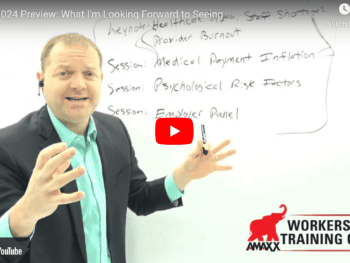Download Documents Referenced In Video:
- 1972 Report: The National Commission on State Workmen’s Compensation Laws
- Letter From Congressional Leaders To Department of Labor Dated October 20, 2015
- The Status of Workers’ Compensation in the United States: A Special Report by Worker’s Injury Law & Advocacy Group (WILAG)
- Improving the Interaction Between the SSDI and Workers’ Compensation: John F. Burton Jr. and Xuguang (Steve) Guo
- NCCI Annual Issues 2015 Report
- The Effect of State Workers’ Compensation Program Changes On the Use of The Federal Social Security Disability Insurance: Melissa P. McInerney & Kosali I. Simon
- ACOEM Letter to NIOSH Re: Prevention of Secondary Work Disability
- ACOEM Guideline: Preventing Needless Work Disability By Helping People Stay Employed
- Key Points From the Americans With Disabilities Act (ADA)
WC National Conversation Series:
- Part #1 WC National Conversation: Political Influence, History, And Current Major WC Issues
- Part #2: WC National Conversation: Imperative Issues and Friction Points
- Part #3: WC National Conversation: Regulations, Unintended Consequences, & Standards
Video Transcript:
Hello, Michael Stack here. Principal of Amaxx, Founder of CompClub and co-author of Your Ultimate Guide to Mastering Workers Comp Costs.
I recently attended the Workers Compensation Summit, which was the start of the National Conversation hosted by Bob Wilson of WorkersCompensation.com and Judge David Langham who is the Chief Deputy Judge of the Florida Office of Judges of Compensation Claims.
National Conversation: Questions About Fairness & Adequacy of Current Workers Comp System
This summit was attended by thirty-nine individuals representing various stakeholders. Because there has been questions about the adequacy and fairness about the current workers compensation system, as well as the future of our industry. So, these stakeholders came together including employees who are injured workers, employers, carriers, TPAs, injured worker’s attorneys, defense attorneys, medical providers, and state regulators. These individuals came together to talk about important issues about where we are today, and where we are going as an industry. As we left that summit after two days one of our main goals was to take the information we discussed, and share it with the industry, because no national discussion is complete without your input, without your perspective. So, I have put together this series to get you up to speed quickly, and be able to join the conversation right where we left off.
3 Part Series To Get You Up To Speed
In this first session I will be reviewing the Pre-Summit Document, which we submitted by the 39 individuals who were in attendance. In all told there were 21 documents submitted, which contained hundreds of pages of materials to be designed as a base of knowledge prior to that discussion. What I will be doing is giving you the highlights and cliff notes from my review of that material, and my notes.
In the second session I will be diving into those discussions that we held over those 2 days in Dallas. I will be talking about the perspectives of the various stake holders, and the different issues that were identified. As well as the imperative issues and friction points that we identified over those 2 day lengthy discussions.
In the third session I will be talking about the regulatory points as well as the incentives we identified that exist and may be causing some challenges. Finally we will wrap up that session with how this conversation continues. So, without further ado, let’s get into the Pre-Summit Documents.
Session #1: Pre-Summit Documents Containing Current National Issues and Political Influence
1972 Report: The National Commission on State Workmen’s Compensation Laws
Ok, so the first report I want to walk you through is The National Commission on State Workmen’s Compensation Laws. This was completed, and submitted, in July of 1972. The first thing I want you to note in this report is who it was written by. John Burton was the Chairman of this commission. We will talk about what was involved in this study, and why I think it was important for us to understand this history as we are reflecting on our current state laws today. John Burton is a name you will want to recognize. He is going to come up a few times over the course of our discussion. John was the chair of this commission, which was a 15-member commission. To give you some context here on what this commission did.
I want to take you now to my notes here, and go over my notes and the things I took from this report. First opening paragraph to reference here to get the contexts is they state, “Congress went on to find, however, that in recent years’ serious questions have been raised concerning the fairness and adequacy of present workmen’s compensation laws in the light of the growth of the economy, the changing nature of the labor force, increases in medical knowledge, changes in the hazards associated with various types of employment, new technology creating new risks to health and safety, and increases in the general level of wages and the cost of living.”
Obviously, very applicable to the conversation that is happening today. So, while there have obviously been changes since this report was written in 1972; a lot of dynamics and politics, policies and state laws, the general nature of the state of the workers’ compensation industry at the time of the writing of this report is very similar I believe to the state of our industry today. This commission was crafted. It was 15 members during President Nixon’s era. It was June 15, 1971. They had one year to do a comprehensive analysis of the state workers compensation system. These 15 members had 11 meetings over the course of that year. They consumed 32 days with on the average, 17 Commissioners in attendance. They also held nine public hearings for a total of 18 days. A lot of time invested in the research of this particular report on the workers’ compensation industry. They also had a full-time staff of 30 employees that assisted those commissioners and they reviewed over two hundred documents that were provided to commissions by the staff. It was a significant investment in time in the analysis of the state workers’ compensation laws. I will review with you what their findings were.
Again, obviously very different today than it was in 1972, but a lot of parallels as to where the state of the industry was at the time. The commission had 5 main objectives of what was found in a modern workers’ compensation system. And as we opened the workers’ compensation summit in Dallas we discussed these five points and agree they are very much still very relevant in today’s system.
The first was the Broad Coverage of Employees and of work-related injuries and diseases. Second, the substantial protection against interruption of income. Third, a provision of sufficient medical care and rehabilitation services. Fourth, Encouragement of safety. And finally, an effective system for delivery of the benefits and services.
I have attached this document of my notes, which highlights some of these different points. You can see the different recommendations that were given by the Commission. There were really 32 recommendations in this summary report they gave. A couple things I want to highlight, and they noted here the essential elements of workers compensation recommendations by this commission. And, we will walk through those now.
And here they are here if you want to go back and take a look through this document. I have noted those numbers on there so you can get further detail on what was included on these recommendations. They recommended Compulsory Coverage, they recommended No Occupational or Numerical Exemptions to Coverage. They recommended Full Coverage for Work Related Diseases, which is still a very relevant topic for today. Full Medical and Physical Rehabilitation Services without Arbitrary Limits; again another very relevant topic today. An employee’s choice of jurisdiction of filing interstate claims. As our economy as grown and there are more companies that are national, and larger in scope, another very relevant topic. And lastly, adequate weekly cash benefits for temporary total, permanent total, and death cases, as well as not arbitrary limits on duration or sum of benefits.
I want to talk a few points of their conclusion here just to give you a scope on what their conclusion were and how they really projected the future. You can see here in this part 3, the future of workers compensation, which is obviously where we are today. They stated, and they concluded that State workman’s compensation laws are in general neither adequate nor equitable. This was their conclusion in 1972.
They go on to say, “we conclude that workman’s compensation is permanently and totally disabled, or is there a rational basis for continuing this program.” They went on to discuss getting rid of the entire system, and they defined this was still inferior to the workers compensation system as it stated.
A couple of challenges they have stated here I think are very relevant today too. They talked about the lack of interest, or understanding of workers compensation by the legislators, and the general public as a whole. That was one of the issues they addressed, and i will talk about in the following video. But, I think a very relevant challenge in our industry today. And even when they do try to make reforms, they don’t really have enough information, and there’s this irrational fear resulting in this competition of states where the employers are going to move their state because of the cost. I think that is a very significant issue to note, and one that is again very relevant today. They rejected the suggestion that Federal administration be submitted for State programs. One of the things they recommended was having the Federal government help the states learn from each other. What is working in on state, and sharing that information. So, that is a summary of the 1972 report.
I want to take you now to the next following issue, which is this issue of where we are today, and why we are having this meeting, and why the 1972 report was originally written. Which is the deterioration of the workers compensation laws, and this question today if workers compensation is a fair and adequate solution. So, a couple of documents that suggests there is interest in changing that, and there is interest at a federal level to now go back to what that discussion was in 1972 report.
Letter From Congressional Leaders To Department of Labor Dated October 20, 2015
So, this was a letter dated October 20, 2015. This was written by 10 members of congress; including Bernie Sanders, who is obviously one of the presidential candidates, which people of very familiar with that name. This statement goes on to reference the 1972 report in this letter to the Department of Labor.
They talk about the 1972 report how it was issued by President Nixon. Goes over that information as we have discussed. They gave 19 essential recommendations. Those federal standards recommended by the commission were never actually enacted but that the Department of Labor annually reported on that states reported compliance on those standards up until 2004. They stated a fact here that since 2003 Legislatures in 33 states have enacted changes to workers compensation laws that has either reduced those benefits, or made it more difficult for workers to qualify for those benefits. And today, only 7 states follow at least 15 of the commissions; 19 of the recommendations, and four states comply with less than half of them. They use this language called the race to the bottom, which not appear to be bottomless when they’re talking about the Opt-out laws. Which the next document I want to take you to references that same sentiment – that same type of language. That same type of idea.
The Status of Workers’ Compensation in the United States: A Special Report by Worker’s Injury Law & Advocacy Group (WILAG)
It is call The Status of Workers’ Compensation in the United States: A Special Report by Worker’s Injury Law & Advocacy Group. I want to take you through this report. It was written in November, 2015. Right around that same time it talks about the history of the grand bargain, but then goes into the sentiment of the great chipping away and really going into the deterioration of those state laws. How those 33 states have enacted laws since 2003. They have reduced those state benefits.
It follows them and uses that same language of the race to the bottom. They re-enforce the idea that there is this growing movement of questioning this fairness and adequacy of the workers’ compensation industry. They then go in to talk about Opt Outs; how that is a threat and the negative impacts that can come from that program.
Improving the Interaction Between the SSDI and Workers’ Compensation: John F. Burton Jr. and Xuguang (Steve) Guo
I want to continue along with these documents, and i want to reference… fast forward now to 2015. As I mentioned, John Burton was a name I want you to know that was a commissioner of that 1972 report. I want to take you to his conclusions and statements. We are going to get back to this idea of SSDI in the next segment. But I want to take you to his conclusions and statements in regards to reflecting on that 1972 report, and how it is relevant today.
This was his solution, saying that the SSDI was not cost shifting to workers’ compensation is the context to this report that he wrote. And he again references the 1972 report and those recommendations that they gave, and again which he was the commissioner in 1972 and the author of this particular report. He goes on the re-emphasize the idea of the competition between the states and how there’s that race to the bottom re-emphasizing that movement of the questioning of the adequacy of the current workers’ compensation.
Now, I want to take you to his conclusion of his regards to those federal stances that they gave in 1972, and why they are not applicable today. So, he writes, “Burton identifies several problems with the proposal to enact federal standards for state WC programs in the twenty-first century, which make this an unrealistic approach to help solve the current financial difficulties of SSDI.” He goes on to now state “the post-1900 developments in WC law that arguably have resulted in cost shifting to SSDI (which was the point of this paper) largely involve changes in compensability (which we just referenced there in that 1972 report as their recommendations) rules that are harder to quantify, such as requirements that the major contributing cause (MCC) of a worker’s disability must be work related.”
So, he talks about how that has been a significant change since they wrote that in 1972 to where things stand today. A major contributing cause is one of the elements we talked about in the Summit held in Dallas, which I will get into in my next video. The idea of a major contributing cause is essentially a 1% aggravation of an existing injury now the employer is responsible for the whole injury vs the idea that it has to be a major contributing cause or 51% contributing cause to that injury for that employer to now deem that compensable.
That’s one of those laws that had been enacted that were referenced in the papers by the congressmen and the WILAG paper that are now reducing those benefits or perceive to be reducing those benefits for the injured workers.
John now goes on to state in this particular paper, “As a result of these problems, further discussion of federal standards as a potential solution is unwarranted despite the considerable virtue of this approach.” So, the political climate, the lot of changes to where we are as a world and as a country make those recommendations, and those federal standards per John’s view and impossible and unwarranted discussion to continue to have in his mind.
SSDI & Cost Shifting to Workers’ Compensation
The next idea I take you to now is the idea of cost shifting from workers compensation to social security disability insurance. There are a couple of papers I want to walk you through and documents to walk you through to give you some of those different perspectives and identification of this issue, because it’s a significant one in this national conversation, and the idea or threat or potential involvement of the federal government in the states worker compensation systems.
NCCI Annual Issues 2015 Report
So, this document here is the NCCI Annual Issues document from 2015, and I want to highlight this little paragraph here; Social Security Disability Insurance. In this first paragraph, they talk about the dramatic increase in the number of beneficiaries in the SSDI program as well as the fact that the trust fund is projected to become insolvent in 2016. Obviously this is a significant issue for the federal government and a potentially motivating driving force to become involved in the workers’ compensation system particularly if there is a significant cost shifting from the workers compensation system to SSDI’s. So, that’s what that first paragraph really references. Then they follow up to say the SSDI could be used by detractors of the state-based system to push for an expanded federal role in workers’ compensation.
Improving the Interaction Between the SSDI and Workers’ Compensation: John F. Burton Jr. and Xuguang (Steve) Guo
So, now let’s talk about that and talk about if that is actually true. I want to show you why this conversation is really happening. And again, this goes back to John Burton’s article. This was a paper that he wrote, this was in 2015 regarding improving the interaction between the SSDI and Workers’ Compensation Programs. And I want to show you why this conversation is happening primarily, and you can see it really very clearly on this graph here. You can see the negative correlation between SSDI, which is in the green, and you can see those costs really escalating every year. While at the same time, the cost of workers’ compensation is decreasing. So, when you look at this from a national level, very plainly in this graph, you can see that negative correlation and very easy to say, well workers comp costs are coming down and SSDI costs are going up, so obviously there is a cost shifting that is occurring there.
Let’s talk about two different papers now that speak to this point. This paper was written by John Burton and is a proponent for that cost shifting and a statement that there is cost shifting that is occurring and he offers a number of different solutions in order to help prevent that. So, one of those is discontinuing the reverse offset. He gives four recommendations here. Improving the design and the implementation of the offset, he talks about experience rating the SSDI program, a number of different things that are not necessarily relevant to this workers compensation conversation but the idea of cost shifting certainly is relevant.
The Effect of State Workers’ Compensation Program Changes On the Use of The Federal Social Security Disability Insurance: Melissa P. McInerney & Kosali I. Simon
Now, I want to take you to this paper which is the effect of state workers compensation program changes on the use of federal social security disability insurance. And this is a study that was done, specifically on this idea of is there a cost shifting that is occurring from the workers’ compensation to the SSDI program. It was a specific study done by the National Bureau of Economic Research in April of 2010. And, I am going to take you to their conclusion here and show you a couple of the different things that they found. So, here is a significant point.
They state that ‘we find the negative correlation between measures of DI and WC receipt which appears in the aggregate national statistics (that was the graph that we just looked at, you could see that negative correlation between those two lines).’ They say, ‘that it’s not upheld at the state level, casting doubt on whether a causal link exists.’ So, when you look at those figures at the aggregate level, there’s a very clear difference, but they are stating that throughout the course of their studies that it does not hold up at the state levels. So, determining, is that actually true? Is there a causal relationship between the two? Here is what they found, they say that although it is possible that a causal relationship between the two programs exist, they argue that the decline in the workers’ compensation outcome is not a significant factor in the increase in the disability insurance outcomes during that same period.
So, throughout the course of this paper, this is a fifty-two page paper, they give back up and data on to how they came to that conclusion, but their analysis – throughout the course of their analysis and this study – was that they did not find a significant correlation between those two programs. However; even though they made that conclusion, you can note that this paper was written in April of 2010. And there are significant references and confusion in this conversation which was noted in that NCII Annual Issues report talking about this cost shifting idea of SSDI.
And again, that’s probably due to the fact that the trust fund is becoming insolvent now in 2016, so the government is now looking for ways and looking for solutions and this could be one of those ways that they are looking at which is one of the main drivers of this conversation. And you go back to this point here, which was the congressman letter that we talked about from October 2015. They go on to speak about the race to the bottom, but on the second page, now they talk about SSDI and how that is a contributing factor in that cost shifting between SSDI and workers compensation and how that is a contributing cause to the insolvency of that SSDI trust fund issue there.
ACOEM Letter to NIOSH Re: Prevention of Secondary Work Disability
And then one more example of this, we’ll talk about this letter in another minute, was a letter to NIOSH from ACOEM, which was the American College of Occupational and Environmental Medicine, Kathryn Mueller and Gary Franklin from the Washington Department of Labor, where they are also referencing this SSDI cost shifting idea. So, a very common idea and a very big part of this conversation and a good thing to understand some of these cost drivers that are in face in place.
Research Supporting Positive Outcomes
So, now I want to take you to the final set of documents, which really now starts to talk about the solutions. And some evidence based medicine and research that has been completed in order to potentially solve some of these problems that we have identified.
ACOEM Guideline: Preventing Needless Work Disability By Helping People Stay Employed
The first document that I want to take you to is the ACOEM Guideline, preventing needless work disability by helping people stay employed. I was very impressed by this document. It was the best piece of research that I have seen from the medical perspective that will drive positive outcomes and integrate solutions into the system. So, I want to give you some examples and some pull out a few points for you to note.
This report basically states that this report focuses on the large number of people who due to a medical condition that should normally result in only a few days of work absence, end up withdrawing from work either permanently or for prolonged periods. And this speaks to the idea, going back to the letter to NIOSH and to the CDC that five percent of injured workers are associated with 80% of cost and lost time in workers compensation systems. Five percent of injured workers are associated with 80% of cost and lost time in workers compensation systems. It is generally agreed that the workers compensation system works for most people. Where these questions of fairness and adequacy come in, come from the smaller percentage of cases, but obviously these smaller percentage of cases are a big piece of some of the challenges and frustrations that are occurring which is why we need to start to address these solutions throughout the course of this conversation.
This particular paper, written by ACOEM, speaks directly to that challenge of how do you take that small number of people that starts as a small or pretty standard run of the mill type of injury and now turns into a significant injury, having a very negative impact on that individual’s life, as well as being very costly for that employer or for that payer.
So, this report goes into great detail on the stay at work and return to work process. We know from a number of studies how valuable that return to work process is in controlling workers compensation costs. And I want to point out a couple of points here to pull out of this paper. I would encourage you to read this in detail. There’s a significant amount of strong information in regards to solutions from the medical perspective.
So, they note ‘while it has been overlooked because of the incorrect assumption that if the medical condition is promptly and properly treated, the worker will naturally return to work.’ And that is an assumption that I believe that we carry through our industry. We look at the medical needs and say, you have a broken arm, your arm is fixed, now you should be back to work. And this paper goes beyond that in looking really at the whole person and some of those other drivers that may be causing some of those five percent of injuries that are causing eighty percent of those costs. It goes on to say that only a small fraction of medically excused days off work are medically necessary, meaning most people should be getting back to work very quickly, and that’s that metric or that benchmark that we incurred that’s 90-95% of workers should be back to work within 0-4 days. And that’s what an organization should be shooting for in a strong return to work program.
I want to highlight this point here, is acknowledging and dealing with normal human reactions, and I think this will help to understand some of that scope as that patient now takes on that sick role or dependent patient role and after becoming ill or injured you now have that right or that freedom to receive care and be free of fault. And I think anyone that has been sick and laying on the couch, dealing with their spouse can relate to that particular point. And I think it’s a good one for us to now understand as we start to dissect and understand some of these solutions and how we can now integrate them into our conversation.
A couple more points here, to pull out from this paper. Reduce the distortion of the medical treatment process by hidden financial agendas. So, this is in disability cases, medical cases are often distorted, with patients often seeking a particular diagnosis or treatments to obtain or maximize benefits. So, this goes back to that idea of this sick role, when you are an injured worker and you are wondering how do I maximize my settlement vs how do I get back to work? And it’s that shift in mindset, which is a very real affect within an individual and a very real affect within a human being for us to consider and how do we now work towards a solution considering these obstacles.
A couple more points here, pay the physicians for disability prevention work to increase their professional commitment. Sitting again, from the physician perspective, which I’ll talk about in the following video when I talk about those perspectives, is when physicians don’t consider disability prevention as part of their job. And in the workers’ compensation space, there are many responsibilities that the physicians are asked, that are typically not in their training or not in their job description. So, understanding that perspective and a few more points here that physicians play an important role in that return to work process is that they are typically given very little information from the employer. They are very rarely getting job descriptions; they are very rarely interacting with that employer to get that person back to work in a timely fashion.
This report was completed by Dr. Jennifer Christian. She was also in attendance at the workers’ compensation summit in Dallas. So, she offered a lot of valuable information in regards to this paper, which leads me to my final point then which is we understand what these solutions are. But there is a big difference between understanding a solution and having something that you can regulate. We know that communication works. We know that getting employees back to work works to control costs, it works to improve outcomes. We know that developing those relationships with medical providers, providing them the information to reference and then getting the employee back to work. Those best practices work and they have been proven both from an employer standpoint and from a medical standpoint.
What I want to highlight here as the last point in this particular segment is that in none of this information, we are talking about regulation, we are talking about SSDI, we are talking about the race to the bottom, very rarely, if ever, do these laws now start to talk about that person. It’s very difficult to regulate solutions, it’s very difficult to regulate emotion behavior incentives. The only piece that I found that references something to that degree was this one piece in the 1972 report that is talking about the proportion of lost wages. And it’s talking about how much should be included and whether or not it’s 2/3rds or 80 percent. But it talks about balancing those incentives between employers to improve safety within the incentives of the disabled to take full advantage of those rehabilitation services and return to work. It’s the only piece that I found, when you are talking about regulation that now speaks to this ACOEM letter, it now speaks to those best practices in regards to return to work, in regards to motivation, and in regards to incentives.
Key Points From the Americans With Disabilities Act (ADA)
So, the last point now to consider is the only law that takes into account these best practices for a solution, the only law that I am aware of anyway, and that’s the Americans with Disabilities act. And I want to take you to some of these key points of the ADA because it’s starting to now regulate human behavior. And this states that at the time of injury a referral to HR and a discussion, referred to as the interactive process regarding reasonable accommodations must occur. Employers are required to provide reasonable accommodation to any employee or applicant with a disability unless doing so would cause undue hardship.
So, the three main takeaways, the three key pieces to understand in regards to the ADA are the interactive process, which simply means a discussion and a conversation, with that individual employee, interacting with that individual and discussing their disability and talking about what accommodations could occur to allow them to continue to do their job unless those would cause an undue hardship. There is a significant amount of gray area within the ADA laws, but this is very optimistic in what it is regulating which is human behavior, regulating that interactive process, regulating that there has to be some communication with that person and regulating that that discussion can lead to potentially making an accommodation for that individual that would allow them to continue their job. It’s a piece of legislation to be aware of as we continue our national discussion on workers compensation.
Thank You for Your Participation in The National Conversation
So, we’ve covered a lot of information throughout this session and in those documents. I want to thank you for your participation and in sticking with it, as well as your interest in this national discussion. Your participation, your thoughts are vital to the continuation of this national conversation in workers compensation.
As I said, in my next video, I’ll be talking about some of those perspectives from the employees, and employers, and carriers, and attorneys, and regulators, etc, that we really reveal throughout the course of those two days and in depth lengthy discussions that we had in Dallas. Also, I’ll be divulging in those imperative issues that we identified, as well as those friction points that we identified in the system.
So, thanks again for your participation and remember your success in workers compensation is defined by your integrity, so be great.
Author Michael Stack, Principal, COMPClub, Amaxx LLC. He is an expert in workers compensation cost containment systems and helps employers reduce their work comp costs by 20% to 50%. He works as a consultant to large and mid-market clients, is co-author of Your Ultimate Guide To Mastering Workers Comp Costs, a comprehensive step-by-step manual of cost containment strategies based on hands-on field experience, and is founder of COMPClub, an exclusive member training program on workers compensation cost containment best practices. Through these platforms he is in the trenches on a working together with clients to implement and define best practices, which allows him to continuously be at the forefront of innovation and thought leadership in workers’ compensation cost containment. Contact: mstack@reduceyourworkerscomp.com.
©2016 Amaxx LLC. All rights reserved under International Copyright Law.
Do not use this information without independent verification. All state laws vary. You should consult with your insurance broker, attorney, or qualified professional.
ESSENTIAL: This article is Return-to-Work Essentials content.











